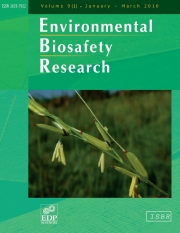Crossref Citations
This article has been cited by the following publications. This list is generated based on data provided by
Crossref.
Fuchs, Marc
Chirco, Ellen M.
and
Gonsalves, Dennis
2004.
Movement of coat protein genes from a commercial virus-resistant transgenic squash into a wild relative.
Environmental Biosafety Research,
Vol. 3,
Issue. 1,
p.
5.
Simard, Marie-Josée
Légère, Anne
Séguin-Swartz, Ginette
Nair, Harikumar
and
Warwick, Suzanne
2005.
Fitness of double vs. single herbicide–resistant canola.
Weed Science,
Vol. 53,
Issue. 4,
p.
489.
HOOFTMAN, DANNY A. P.
OOSTERMEIJER, J. GERARD B.
JACOBS, MIRJAM M. J.
and
DEN NIJS, HANS C. M.
2005.
Demographic vital rates determine the performance advantage of crop–wild hybrids in lettuce.
Journal of Applied Ecology,
Vol. 42,
Issue. 6,
p.
1086.
Guadagnuolo, R.
Clegg, J.
and
Ellstrand, N. C.
2006.
RELATIVE FITNESS OF TRANSGENIC VS. NON-TRANSGENIC MAIZE × TEOSINTE HYBRIDS: A FIELD EVALUATION.
Ecological Applications,
Vol. 16,
Issue. 5,
p.
1967.
Campbell, Lesley G.
Snow, Allison A.
and
Ridley, Caroline E.
2006.
Weed evolution after crop gene introgression: greater survival and fecundity of hybrids in a new environment.
Ecology Letters,
Vol. 9,
Issue. 11,
p.
1198.
Harriman, Robert W.
Bolar, Jyothi Prakash
and
Smith, Franzine D.
2006.
Importance of Biotechnology to the Horticultural Plant Industry.
Journal of Crop Improvement,
Vol. 17,
Issue. 1-2,
p.
1.
Felber, François
Kozlowski, Gregor
Arrigo, Nils
and
Guadagnuolo, Roberto
2007.
Green Gene Technology.
Vol. 107,
Issue. ,
p.
173.
HOOFTMAN, DANNY A. P
JONG, MAAIKE J. DE
OOSTERMEIJER, J. GERARD B
and
DEN NIJS, HANS (J.) C. M
2007.
Modelling the long‐term consequences of crop–wild relative hybridization: a case study using four generations of hybrids.
Journal of Applied Ecology,
Vol. 44,
Issue. 5,
p.
1035.
Campbell, Lesley G.
and
Snow, Allison A.
2007.
Competition alters life history and increases the relative fecundity of crop–wild radish hybrids (Raphanusspp.).
New Phytologist,
Vol. 173,
Issue. 3,
p.
648.
Fuchs, Marc
and
Gonsalves, Dennis
2007.
Safety of Virus-Resistant Transgenic Plants Two Decades After Their Introduction: Lessons from Realistic Field Risk Assessment Studies.
Annual Review of Phytopathology,
Vol. 45,
Issue. 1,
p.
173.
Hooftman, Danny A.P.
Nieuwenhuis, Bart P.S.
Posthuma, Karin I.
Oostermeijer, J. Gerard B.
and
den Nijs, Hans (J.) C.M.
2007.
Introgression potential of downy mildew resistance from lettuce to Lactuca serriola and its relevance for plant fitness.
Basic and Applied Ecology,
Vol. 8,
Issue. 2,
p.
135.
Mercer, Kristin L.
Andow, David A.
Wyse, Donald L.
and
Shaw, Ruth G.
2007.
Stress and domestication traits increase the relative fitness of crop–wild hybrids in sunflower.
Ecology Letters,
Vol. 10,
Issue. 5,
p.
383.
Morroni, Marco
Thompson, Jeremy R.
and
Tepfer, Mark
2008.
Twenty Years of Transgenic Plants Resistant toCucumber mosaic virus.
Molecular Plant-Microbe Interactions®,
Vol. 21,
Issue. 6,
p.
675.
Quemada, Hector
Strehlow, Laura
Decker-Walters, Deena S.
and
Staub, Jack E.
2008.
Population size and incidence of virus infection in free-living populations ofCucurbita pepo.
Environmental Biosafety Research,
Vol. 7,
Issue. 4,
p.
185.
Fuchs, M.
2008.
Encyclopedia of Virology.
p.
156.
Chandler, Stephen
and
Dunwell, Jim M.
2008.
Gene Flow, Risk Assessment and the Environmental Release of Transgenic Plants.
Critical Reviews in Plant Sciences,
Vol. 27,
Issue. 1,
p.
25.
Laughlin, Karen D.
Power, Alison G.
Snow, Allison A.
and
Spencer, Lawrence J.
2009.
Risk assessment of genetically engineered crops: fitness effects of virus‐resistance transgenes in wild Cucurbita pepo.
Ecological Applications,
Vol. 19,
Issue. 5,
p.
1091.
Warwick, Suzanne I.
Beckie, Hugh J.
and
Hall, Linda M.
2009.
Gene Flow, Invasiveness, and Ecological Impact of Genetically Modified Crops.
Annals of the New York Academy of Sciences,
Vol. 1168,
Issue. 1,
p.
72.
Sasu, Miruna A.
Ferrari, Matthew J.
Du, Daolin
Winsor, James A.
and
Stephenson, Andrew G.
2009.
Indirect costs of a nontarget pathogen mitigate the direct benefits of a virus-resistant transgene in wild
Cucurbita
.
Proceedings of the National Academy of Sciences,
Vol. 106,
Issue. 45,
p.
19067.
Sasu, Miruna A.
Ferrari, Matthew J.
and
Stephenson, Andrew G.
2010.
Interrelationships among a Virus-Resistance Transgene, Herbivory, and a Bacterial Disease in a Wild Cucurbita.
International Journal of Plant Sciences,
Vol. 171,
Issue. 9,
p.
1048.


